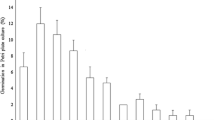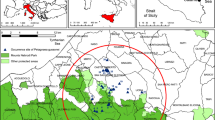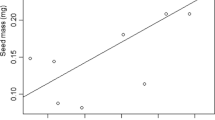Abstract
Cassava is clonally propagated, but Amerindian farmers also use plants from volunteer seedlings to prepare stem cuttings. Although sexual reproduction plays a role in cassava’s evolution it is poorly studied. We examined one aspect of cassava reproductive ecology, seed dormancy and germination. Volunteer seedlings emerge from a soil bank of seeds produced during the previous cycle of cultivation that remain ungerminated through the fallow period, then germinate synchronously after vegetation is slashed and burned. Laboratory experiments showed that germination can be enhanced by mechanical scarification and also by dry heat treatment, suggesting that burning after field clearing could help break dormancy. Germination was also stimulated by high temperatures (35°C) that in nature indicate bare soils, and inhibited by temperatures (25°C) close to those in soil shaded by vegetation and by light. Seeds of both wild and domesticated cassava exhibit physiological dormancy, an adaptation for germination in periodically disturbed habitats. In addition to these preadaptations, preliminary results also suggest specific adaptations of domesticated cassava to the distinctive disturbance regimes of swidden agriculture.
Similar content being viewed by others
Literature Cited
Allem, A. C. 1994. The origin ofManihot esculenta Crantz (Euphorbiaceae). Genetic Resources and Crop Evolution 41:133–150.
— 1999. The closest wild relatives of cassava (Manihot esculenta Crantz). Euphytica 107:123–133.
Balee, W. 1993. Indigenous transformation of Amazonian forests. L’Homme 33:231–254.
Baskin.C C., and J. M. Baskin. 1998. Seeds. Ecology, biogeography and evolution of dormancy and germination. Academic Press, San Diego.
Bianchini, M., and E. Pacini. 1996. The caruncle ofRicinus communis L. (castor bean): its development and role in seed dehydration, rehydration, and germination. International Journal of Plant Sciences 157:40–48.
Biggs, B. J., M. K. Smith, and K. J. Scott. 1986 The use of embryo culture for the recovery of plants from cassava (Manihot esculenta Crantz) seeds. Plant Cell, Tissue and Organ Culture 6:229–232.
Boster, J. S. 1984. Classification, cultivation, and selection of Aguaruna cultivars ofManihot esculenta (Euphorbiaceae). Advances in Economic Botany 1: 34–47.
Brush, S. B. 1995. In situ conservation of landraces in centers of crop diversity. Crop Science 35:346–354.
Biilow-Olsen, A. 1984. Diplochory inViola: a possible relation between seed dispersal and soil seed bank. American Midland Naturalist 112:251–260.
Cury, R. 1993. Dinâmica evolutiva e caracterizaÇão de germoplasma de mandioca (Manihot esculenta Crantz), na agricultura autóctone do Sul do Estado de São Paulo. Master’s thesis, Univ. São Paulo Esc. Super. Agric.-Luiz de Queiroz, Piracicaba, Brazil.
Egley, G. H. 1995. Seed germination in soil: dormancy cycles. Pages 529–544in J. Kigel and G. Galili, eds., Seed development and germination. Marcel Dekker, New York, NY.
Elias, M. 2000. Sélection naturelle, sélection humaine, et diversité chez une plante domestique propagée de façon végétative: le cas de la culture du manioc par les Indiens Makushi du Guyana. Thése, Université Montpellier II, Montpellier, France.
—,D. McKey, O. Panaud, M. C. Anstett, and T. Robert. 2001a. Traditional management of cassava morphological and genetic diversity by the Makushi Amerindians (Guyana, South America): perspectives for on-farm conservation of crop genetic resources. Euphytica 20:143–157.
—,andD. McKey 2000. The unmanaged reproductive ecology of domesticated plants in traditional agroecosystems: an example involving cassava and a call for data. Acta Oecologica 21:223–230.
—,O. Panaud, and T. Robert. 2000. Assessment of genetic variability in a traditional cassava (Manihot esculenta Crantz) farming system, Using AFLP markers. Heredity 85:219–230.
—,L. Penet, P. Bertolino, P. Vindry, D. McKey, O. Panaud, and T. Robert. 2001b. Unmanaged sexual reproduction in a vegetatively propagated crop, cassava (Manihot esculenta Crantz) and dynamics of genetic diversity assessed with microsatellite markers. Molecular Ecology 10: 1895–1907.
—,L. Rival, and D. McKey. 2000. Perception and management of cassava (Manihot esculenta Crantz) diversity among Makushi Amerindians of Guyana (South America). Journal of Ethnobiology 20:239–265.
Ellis, R. H., T. D. Hong, and E. H. Roberts. 1982 An investigation of the influence of constant and alternating temperature on the germination of cassava seed using a two-dimensional temperature gradient plate. Annals of Botany 49:241–246.
—,T. D. Hong, and E. H. Roberts. 1985. Handbook of seed technology for gene banks. 2 vols. International Board for Plant Genetic Resources, Rome.
Ellstrand, N., H. C. Prentice, and J. F. Hancock. 1999. Gene flow and introgression from domesticated plants into their wild relatives. Annual Review of Ecology and Systematics 30:539–563.
Espalader, X., and C. Gomez. 1996. Seed production, predation and dispersal in the Mediterranean myrmecochoreEuphorbia characias (Euphorbiaceae). Ecography 19:7–15.
Fenner, M. 1995. Ecology of seed banks. Pages 507–528in J. Kigel and G. Galili, eds., Seed development and germination. Marcel Dekker, New York, NY.
Fregene, M., J. A. Ospina, and W. Roca. 1999. Recovery of cassava (Manihot esculenta Crantz) plants from culture of immature zygotic embryos. Plant Cell, Tissue and Organ Culture 55:39–43.
Johns, T., and S. L. Keen. 1986. Ongoing evolution of the potato on the altiplano of western Bolivia. Economic Botany 40:409–424.
Kearns, C. A., and D. W. Inouye. 1993. Techniques for pollination biologists. University Press of Colorado, Niwot, Colorado.
Keeley, J. E. 1991. Seed germination and life history syndromes in the California chaparral. Botanical Reviews 57:81–116.
Lagôa, A. M. M. A., and M. F. A. Pereira. 1987. The role of the caruncle in the germination of seeds ofRicinus communis. Plant Physiology and Biochemistry 25:125–128.
Lozano, 00J. C, and B. L. Nolt. 1989. Pests and pathogens of cassava. Pages 169–182in R. P. Kahn, ed., Plant protection and quarantine, Vol. II. Selected pests and pathogens of quarantine significance. CRC Press, Boca Raton, Florida, USA.
McKey, D., and S. Beckerman. 1993. Chemical ecology, plant evolution and traditional manioc cultivation systems. Pages 83–112in C. M. Hladik, A. Hladik, H. Pagezy, O. F. Linares, G. J. A. Koppert and A. Froment, eds., Tropical forests, people and food, UNESCO, Paris.
—,L. Emperaire, M. Elias, F. Pinton, T. Robert, S. Desmouliére, andL. Rival. 2001. Gestions locales et dynamiques régionales de la diversité variétale du manioc en Amazonie. Génétique, Sélection et Evolution 33(Suppl. l):S465-S490.
Mendes, R. A. 1981. Melhoramento na germinaÇão de semente botânica de mandioca (Manihot esculenta Crantz). Pages 523–539in Anais i Congresso Brasileira de Mandioca, vol. 1. Pesquisas agronômicas. Embrapa-Did, Salvador, SBM, Brazil.
Nartey, F. 1978.Manihot esculenta (cassava, tapioca, manioc, mandioca, yuca): cyanogenesis, ultrastructure and seed germination. Munksgaard, Copenhagen.
Nassar, N. M. A., and R. P. Teixeira. 1983. A quebra da dorméncia da semente das espécies selvagens da mandioca.Manihot spp. Ciéncia e Cultura 35:630–632.
Olsen, K. M., and B. A. Schaal. 1999. Evidence on the origin of cassava: phylogeography ofManihot esculenta. Proceedings of the National Academy of Sciences, USA 96:5586–5591.
—,and B. A. Schaal. 2001. Microsatellite variation in cassava (Manihot esculenta, Euphorbiaceae) and its wild relatives: further evidence for a southern Amazonian origin of domestication. American Journal of Botany 88:131–142.
Pacini, E. 1990.Mercurialis annua L. (Euphorbiaceae) seed interactions with the antMessor structor (Latr.), Hymenoptera: Formicidae. Acta Botanica Neerlandica 39:253–262.
Passos, L., and S. O. Ferreira. 1996. Ant dispersal ofCroton priscus (Euphorbiaceae) seeds in a tropical semideciduous forest in southern Brazil. Biotropica 28:697–700.
Pyne, S. J. 1998. Forged in fire: history, land, and anthropogenic fire. Pages 64–103in W. Balée, ed., Advances in Historical Ecology. Columbia University Press, New York.
Roa, A. C., M. M. Maya, M. C. Duque, J. Tohme, A. C. Allem, and M. W. Bonierbale. 1997. AFLP analysis of relationships among cassava and otherManihot species. Theoretical and Applied Genetics 95:741–750.
Salick, J., N. Cellinese, and S. Knapp. 1997. Indigenous diversity of cassava: generation, maintenance, use and loss among the Amuesha, Peruvian upper Amazon. Economic Botany 51:6–19.
Sambatti, J. B. M., P. S. Martins, and A. Ando. 2001. Folk taxonomy and evolutionary dynamics of cassava: a case study in Ubatuba, Brazil. Economic Botany 55:93–105.
SAS. 1996. SAS/STAT User’s guide, Release 6.12. Cary, N.C.: SAS Institute.
Second, G., A. C. Allem, R. A. Mendes, L. J. C. B. Carvalho, L. Emperaire, C. Ingram and C. Colombo. 1997. Molecular marker (AFLP)-basedManihot and cassava numerical taxonomy and genetic structure analysis in progress: implications for their dynamic conservation and genetic mapping. African Journal of Root and Tuber Crops 2:140–147.
Shigeta, M. 1996. Creating landrace diversity: the case of the Ari people and ensete (Ensete ventricosum) in Ethiopia. Pages 233–268in R. Ellen and K. Fukui, eds., Redefining nature: ecology, culture and domestication. Oxford University Press, Oxford.
Soleri, D., and S. E. Smith. 1995. Morphological and phenological comparisons of two Hopi maize varieties conserved in situ and ex situ. Economic Botany 49:56–77.
Tardy, C. 1998. Paleoincendies naturels, feux anthropiques et environnements forestiers de Guyane francaise du tardiglaciaire à l’Holocène récent. Thèse, Université Montpellier II, Montpellier, France.
Thompson, K., and J. P. Grime. 1983. A comparative study of germination responses to diurnally-fluctuating temperatures. Journal of Applied Ecology 20:141–156.
Vazquez-Yanes, C. 1980. Light quality and seed germination inCecropia obtusifolia andPiper auritum from a tropical rain forest in Mexico. Phyton 38: 33–35.
Wilson, H. D. 1990. Gene flow in squash species. BioScience 40:449–455.
Yen, D. E. 1974. The sweet potato and Oceania: an essay in ethnobotany. Bernice P. Bishop Museum Bulletin 236, Bishop Museum Press, Honolulu.
Author information
Authors and Affiliations
Rights and permissions
About this article
Cite this article
Pujol, B., Gigot, G., Laurent, G. et al. Germination ecology of Cassava (Manihot esculenta Crantz, Euphorbiaceae) in traditional agroecosystems: Seed and seedling biology of a vegetatively propagated domesticated plant. Econ Bot 56, 366–379 (2002). https://doi.org/10.1663/0013-0001(2002)056[0366:GEOCME]2.0.CO;2
Issue Date:
DOI: https://doi.org/10.1663/0013-0001(2002)056[0366:GEOCME]2.0.CO;2




